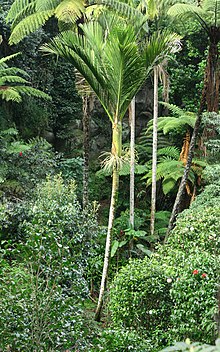Nikau palm
| Nīkau | |
|---|---|
 |
|
| Scientific classification | |
| Kingdom: | Plantae |
| (unranked): | Angiosperms |
| (unranked): | Monocots |
| (unranked): | Commelinids |
| Order: | Arecales |
| Family: | Arecaceae |
| Subtribe: | Rhopalostylidinae |
| Genus: | Rhopalostylis |
| Species: | R. sapida |
| Binomial name | |
|
Rhopalostylis sapida H.Wendl. & Drude |
|
The nīkau (Rhopalostylis sapida) is a palm tree endemic to New Zealand, and the only palm native to New Zealand.
Nīkau is a Māori word; in the closely related Eastern Polynesian languages of the tropical Pacific, it refers to the fronds or the midrib of the coconut palm.
The nīkau palm is the only palm species endemic to mainland New Zealand. Its natural range is coastal and lowland forest on the North Island, and on the South Island as far south as Okarito mostly in humidity (43°20′S) in the west and Banks Peninsula (43°5′S) in the east. It also occurs on Chatham Island and Pitt Island/Rangiauria to the south-east of New Zealand, where it is the world's southernmost palm at 44° 18'S latitude.
The nīkau grows up to 15 m tall, with a stout, green trunk which bears grey-green leaf scars. The trunk is topped by a smooth, bulging crownshaft up to 1m long. The fronds are up to 3 m long, and the closely set, sometimes overlapping leaflets are up to 1 m long. The inflorescence is multibranched and from 200 to 400 mm long. The tightly packed flowers are unisexual and coloured lilac to pink. Male flowers are borne in pairs, and have six stamens. The female flowers are solitary. The fruit is elliptic or oblong, and generally measures about 10 by 7 mm, and is red when ripe. The nīkau produces flowers between November and April, and fruits ripen from February to November, taking almost a year to fully ripen. These are a preferred food of the kererū, the native wood pigeon.
The nīkau makes an excellent potted plant, and is quite hardy. It tends to be slow-growing. It grows readily from seed if the fruit is soaked in water for a few days and then gently scrubbed to remove the flesh. The seed will then germinate readily if placed in sealed plastic bags in partial shade, after which they can be planted in deep pots. The pots should be tall and narrow to provide room for the taproot and to lessen the likelihood of root damage when transplanting.
...
Wikipedia

